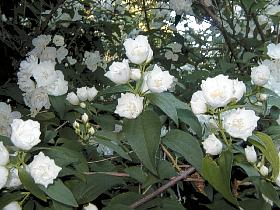Mock Orange, Philadelphus coronarius 
Bush of the family Hydrangeaceae (Deutzia, Hydrangea, Hydrangée, Mock Orange)
 Etymology: Etymology:
"Mock orange " recalls the sweet smell like that of orange tree. The word Philadelphus indicated in antiquity a very fragrant shrub. Philadelphus was also the nickname of King Ptolemy II of Egypt.
Origin: tempered regions in the north hemisphere.
Habitat: Mock Orange makes the best of all types of soils, including poor and calcareous soils. It prefers however fertile fields and well drained, of neutral or sour Ph. It appreciates sunny position but supports half shade.
Hardiness: Mock Orange is hardy (zone 6). It goes well in all regions of France.
Shape: spread in arched branches.
Maximum size: 5 m tall.
Flowers: species monoecious; white, small flowers (2 - 4 cm), in May-June, grouped by 5-9 in tip of branches. Very fragrant and very abundant flowers. They attract the honeybees.
Deciduous foliage. Dark green, oval, opposite and simple leaves, acuminate and slightly toothed. From 8 to 10 cm long.
Fruits: capsule, persistent until spring.
Use: Free Hedge, shrubbery or borders. Its abundant and deliciously fragrant blossoming is appreciated.
Planting: Plant Mock Orange preferably during the period of dormancy (from October to February) so that they can grow comfortably and bloom from the first year.
Propagation: by herbaceous cutting in June and July, in greenhouse, or by cutting of dry wood during the period of dormancy between November and February.
Advices of maintenance: when to prune Mock Orange?
From July, prune the faded inflorescences, it will allow the plant to bloom again better the next year. Remove the old branches and empty the centre of the shrub. Do not prune the branches of the previous year in spring, because flowers grow on this wood.
Do not confuse:
- with Deutzie. Mock Orange has bigger flowers, with four petals (five for Deutzies) and fragrant ; their stems contain pith, those of Deutzies being hollow.
- with Syringa, which was its name until Linné allocates it to the lilac, preferring the Latin name Philadelphus for the Mock Orange. |